Google Nexus 9: Preliminary Findings
by Joshua Ho on November 3, 2014 1:00 PM ESTCPU Performance
While there’s a great deal of ground to cover on the tablet as a whole, one of the most interesting aspects of the Nexus 9 is the SoC. While we’ve tested Tegra K1 before, we were looking at the more traditional Cortex A15 variant. The Denver variant (Tegra13x) is mostly similar to Tegra K1-32 (Tegra12x), but instead the CPU cores are a radically different design. In order to get an idea for how this translates into real world we can look at a few of our standard benchmarks in this area, although Google Octane couldn’t complete a full run. This build of Android clearly has AArch64 active, which means that we should be able to directly compare the Nexus 9 to the iPad Air 2 for performance.
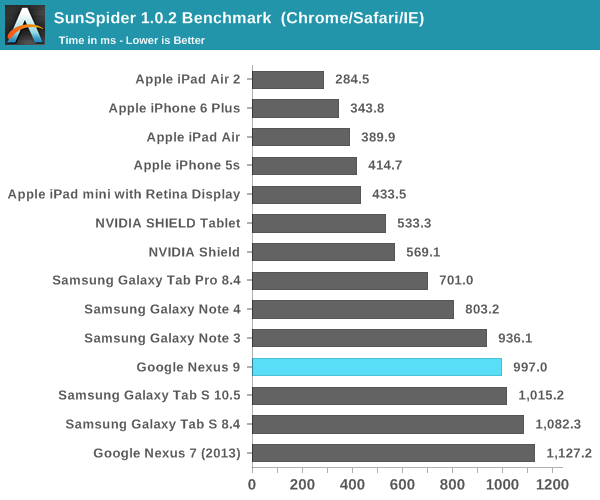
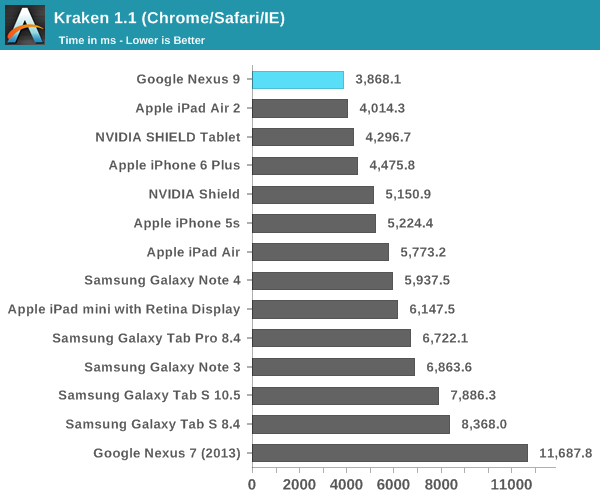

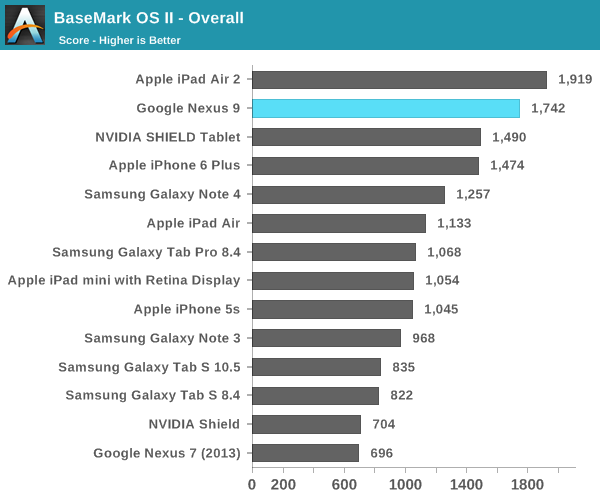
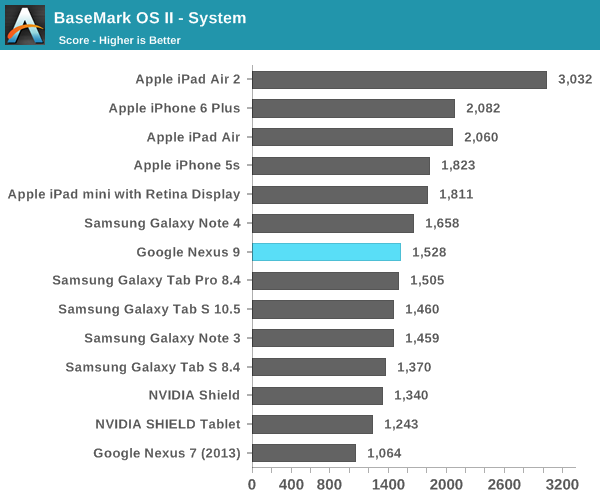
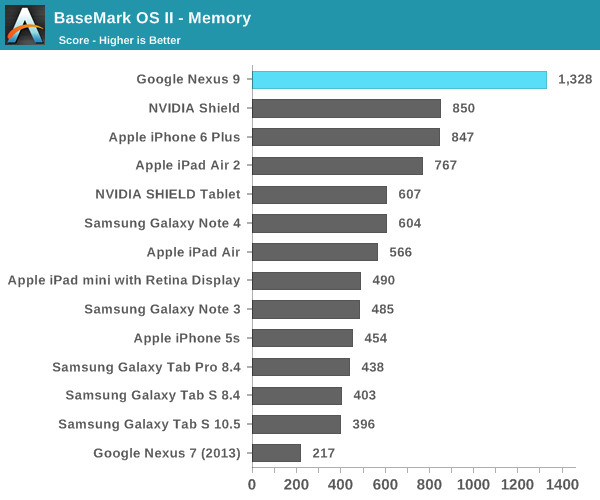
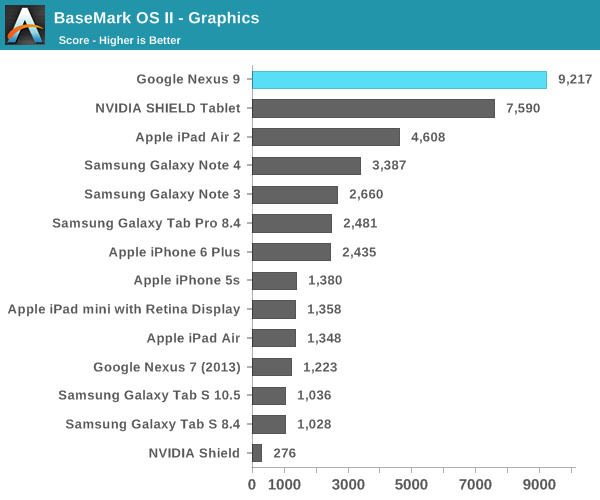
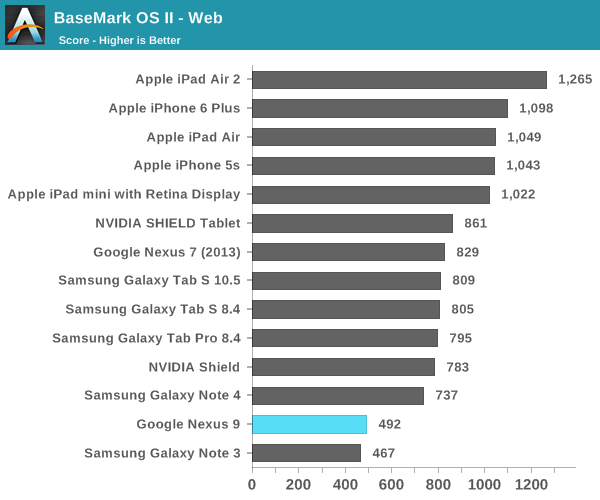
As one can see, at least at this stage in development the Nexus 9 can show some level of promise at times, but can be a bit disappointing in others. In SunSpider, Denver is generally even slower than Krait. However, in a benchmark like Kraken the Nexus 9 easily pulls ahead to take the top spot. In Basemark OS II the Nexus 9 does well overall but this seems to be due to its graphics performance/GPU performance and storage performance rather than CPU-bound tests like the system and web tests. It seems that when the code morphing systems works as expected, Denver can deliver significant amounts of performance. However, when such code morphing falls flat its true performance with a dual core, 2.3 GHz configuration is around that of a four Krait core CPU system at similar clock speeds. Once again, it's important to emphasize that this build is far from complete so performance should improve across the board with launch software. The fact that Tegra13x can approach A8X in CPU performance in some tests is definitely interesting to see.
Battery Life
While Denver's performance is a bit mixed, it's worth taking a look at battery life to see how Denver performs in these areas. As always, our battery life tests are all run with the display calibrated to 200 nits.
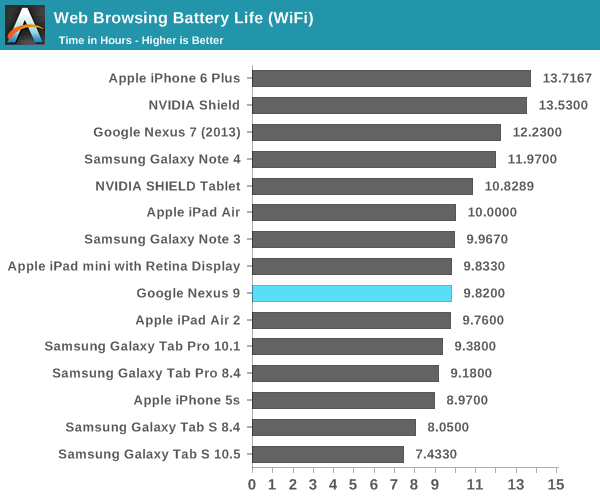
While an early build, it seems that the Nexus 9 is reasonably competitive in battery life but I'm not sure that these results are perfectly accurate. At any rate, efficiency at this stage seems to be par for the course, which should bode well for shipping software. This is a mostly display-bound test though, so we'll look at Basemark OS II to get a better idea for compute-bound battery life.
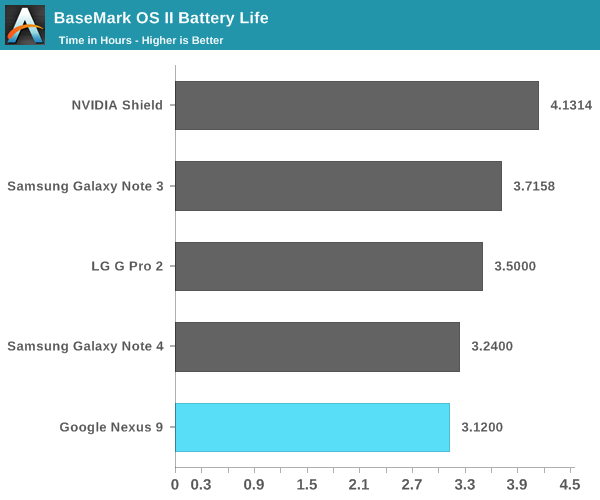

As one can see, while the battery life of the Nexus 9 ends up on the bottom for phablets and tablets, the overall performance during the test is quite high. We're working on a better comparison for the final review, but this should give a good idea of what to expect in general.










146 Comments
View All Comments
kron123456789 - Tuesday, November 4, 2014 - link
It's not about power, it's about how you can use that power. On Windows there are many ways to use power of any Core chip, on iOS there is pretty much no way you can use power of A8X.DERSS - Wednesday, November 5, 2014 - link
Easy; Apple has shown heavy load iPad Air 2 applications during presentation.kron123456789 - Wednesday, November 5, 2014 - link
Yup. It's like...two of them, yeah? That's definitely makes a difference.ins1dious - Wednesday, November 5, 2014 - link
Have to start somewhere... I was more impressed with the pixelmator demohttps://www.youtube.com/watch?v=sBfvJn-fpnc#t=3138
I think these ARM chips will start to become more useful once more and more developers take advantage of their power.
DERSS - Thursday, November 6, 2014 - link
@kron, you wrote "But pretty much no way you can use power of A8X", which directly wrong. By now there are already few dozens of heavy load apps that load things (many graphics-related, medical processing pro apps, and so on).kron123456789 - Thursday, November 6, 2014 - link
I bet those apps are working well with A7 chip. Correct me if i'm wrong.ins1dious - Thursday, November 6, 2014 - link
@kron - but with Pixelmator as example... you see 2x performance. Isn't that good?testbug00 - Tuesday, November 4, 2014 - link
The Tegra chip should be some where around equal on Integer and about a half(!) the FP performance of the A8X.retrospooty - Monday, November 3, 2014 - link
"Overall this device I think missed on the lack of expandable storage and low entry level 16GB storage. "Yup. This one boggles the mind. They did 32gb on the Nexus 6. WTF is with 16gb as a start point for a high end tablet? Other than that, its a pretty darn good tablet though. Amazing GPU.
tipoo - Monday, November 3, 2014 - link
Denver looks like some good design choices. 2 big cores are better than 4 scrawny ones, glad to see Android SoC makers learn that, ironically it's the same one that sent everyone chasing 4 cores. The VLIW+Code morphing architecture is interesting, in thoery it would take a hit from spaghetti code, but with 128MB of far caching it shouldn't really run into situations where it's reoptimizing the same code a lot.